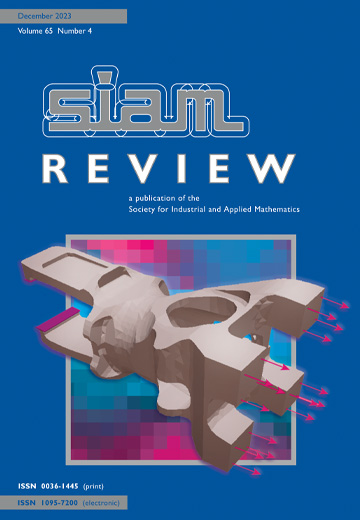SIGEST
IF 10.8
1区 数学
Q1 MATHEMATICS, APPLIED
引用次数: 0
摘要
SIAM评论,第65卷第3期,第829-829页,2023年8月。本期SIGEST的文章来自SIAM/ASA关于不确定性量化的期刊,是Jonas Latz的《贝叶斯反问题通常是好姿势的》。作者研究了反问题贝叶斯方法的适定性,将Andrew Stuart引入的适定性框架推广到一组较弱的假设中。这里的适定性是在Hadamard的意义上理解的,也就是说,一个解是存在的,是唯一的,并且持续依赖于输入数据。由于模型的特性、数据的缺乏和测量噪声,逆问题通常是不适定的。反问题的贝叶斯方法根据对其后验分布的追求来重新表述对反问题解的追求,后验分布由解的数据似然性和先验分布决定,并且与反问题本身相比,该后验分布应该是适定的。在贝叶斯上下文中,适定性通常与后验分布相对于所谓Hellinger距离中的数据的存在性、唯一性和Lipschitz连续性有关。在许多实际应用中,这种适定性即使不是不可能,也很难验证。此外,根据手头的问题,选择Hellinger距离作为正确的度量可能并不总是最合适的。这为论文奠定了起点,作者介绍了一个新的贝叶斯反问题适定性框架,在该框架中,他展示了一大类贝叶斯反问题的存在性、唯一性和连续性,条件是在实际环境中不受限制或可验证的。本文为贝叶斯反问题提供了一个新的数学基础。对基本的统计和概率概念进行了全面和可理解的解释,从而为广大读者打开了贝叶斯方法的大门。对于SIGEST版本的论文,作者介绍了更多的背景材料,使其更容易为普通读者所接受,并扩展了结论和展望部分,总结了自原作发表以来该领域的发展,并讨论了未来的研究方向。本文章由计算机程序翻译,如有差异,请以英文原文为准。
SIGEST
SIAM Review, Volume 65, Issue 3, Page 829-829, August 2023.
The SIGEST article in this issue, which comes from the SIAM/ASA Journal on Uncertainty Quantification, is “Bayesian Inverse Problems Are Usually Well-Posed,” by Jonas Latz. The author investigates the well-posedness of Bayesian approaches to inverse problems, generalizing the framework of well-posedness introduced by Andrew Stuart to a set of weaker assumptions. Well-posedness here is understood in the sense of Hadamard, that is, a solution exists, is unique, and continuously depends on the input data. Inverse problems are typically ill-posed due to properties of the model, a lack of data, and measurement noise. The Bayesian approach to inverse problems reformulates the quest for a solution to the inverse problem in terms of a quest for its posterior distribution, which is determined by the data likelihood and prior distribution of the solution, and which in contrast to the inverse problem itself should be well-posed. In the Bayesian context, well-posedness typically relates to existence, uniqueness, and Lipschitz continuity of the posterior distribution with respect to the data in the so-called Hellinger distance. In many practical applications such well-posedness is difficult, if not impossible, to verify. Moreover, the choice of the Hellinger distance as the right metric might not always be the best fitted depending on the problem at hand. This sets the starting point for the paper where the author introduces a new framework for well-posedness of Bayesian inverse problems in which he shows existence, uniqueness, and continuity with respect to various metrics for a large class of Bayesian inverse problems, with conditions that are either nonrestrictive or verifiable in practical settings. This paper gives a strong new mathematical foundation for Bayesian inverse problems. The underlying statistical and probabilistic concepts are explained comprehensively and comprehensibly and, thus, in a way that opens up the Bayesian approach for a large readership. For the SIGEST version of the paper the author introduced more background material to make it more accessible to a general audience and extended the conclusion and outlook section, summarizing developments in the field that happened since the publication of the original work and discussing future research directions.
The SIGEST article in this issue, which comes from the SIAM/ASA Journal on Uncertainty Quantification, is “Bayesian Inverse Problems Are Usually Well-Posed,” by Jonas Latz. The author investigates the well-posedness of Bayesian approaches to inverse problems, generalizing the framework of well-posedness introduced by Andrew Stuart to a set of weaker assumptions. Well-posedness here is understood in the sense of Hadamard, that is, a solution exists, is unique, and continuously depends on the input data. Inverse problems are typically ill-posed due to properties of the model, a lack of data, and measurement noise. The Bayesian approach to inverse problems reformulates the quest for a solution to the inverse problem in terms of a quest for its posterior distribution, which is determined by the data likelihood and prior distribution of the solution, and which in contrast to the inverse problem itself should be well-posed. In the Bayesian context, well-posedness typically relates to existence, uniqueness, and Lipschitz continuity of the posterior distribution with respect to the data in the so-called Hellinger distance. In many practical applications such well-posedness is difficult, if not impossible, to verify. Moreover, the choice of the Hellinger distance as the right metric might not always be the best fitted depending on the problem at hand. This sets the starting point for the paper where the author introduces a new framework for well-posedness of Bayesian inverse problems in which he shows existence, uniqueness, and continuity with respect to various metrics for a large class of Bayesian inverse problems, with conditions that are either nonrestrictive or verifiable in practical settings. This paper gives a strong new mathematical foundation for Bayesian inverse problems. The underlying statistical and probabilistic concepts are explained comprehensively and comprehensibly and, thus, in a way that opens up the Bayesian approach for a large readership. For the SIGEST version of the paper the author introduced more background material to make it more accessible to a general audience and extended the conclusion and outlook section, summarizing developments in the field that happened since the publication of the original work and discussing future research directions.
求助全文
通过发布文献求助,成功后即可免费获取论文全文。
去求助
来源期刊

SIAM Review
数学-应用数学
CiteScore
16.90
自引率
0.00%
发文量
50
期刊介绍:
Survey and Review feature papers that provide an integrative and current viewpoint on important topics in applied or computational mathematics and scientific computing. These papers aim to offer a comprehensive perspective on the subject matter.
Research Spotlights publish concise research papers in applied and computational mathematics that are of interest to a wide range of readers in SIAM Review. The papers in this section present innovative ideas that are clearly explained and motivated. They stand out from regular publications in specific SIAM journals due to their accessibility and potential for widespread and long-lasting influence.
 求助内容:
求助内容: 应助结果提醒方式:
应助结果提醒方式:


